#Research Material
Explore tagged Tumblr posts
Text
Fun Ocean Planet Facts I love learning for my book
A water planet needs a strong magnetic field to protect its atmosphere, otherwise greenhouse gases will cause the planet to heat up over time, the ocean to boil, and vapour to escape into space via solar wind (like Venus and Mars)
Gas giants like Jupiter and Saturn, thought to lack surfaces and have a stratum of liquid nitrogen.
Although still not fully understood, ice giants like Uranus and Neptune have hot, highly compressed, supercritical water. However, the "ocean" on Neptune, might actually be liquid diamond.
There are currently five known water planets in habitable zones. Kepler-22b "Super Earth" is 2.4 times the size of Earth. It is currently unknown if it has a rocky, gaseous or liquid composition, but it does have clouds.
Kepler-453b is 60% bigger than Earth, orbiting a star 10% larger than our sun and 20% brighter. The temperature is warm enough to have an ocean and house life.
Kepler-62 has five planets orbiting a star 2/3 the size of our sun and only 1/5 as bright. At 7 billion years old it is older than our solar system and two of the planets are habitable zones and 40% larger than Earth.
HAT-P-11b is a planet the size of Neptune, making it the smallest exoplanet to have water, it sits so close to its sun in a five-day orbit, it's too warm to have an ocean, but it still has water vapour and cloudless skies.
Ganymede (Jupiter's largest moon) proves that satellites can have their own magnetic field and underground saltwater oceans.
Callisto, Jupiter's second largest moon, is equal parts rock and ice with the lowest density of any moon. Its structure is composed of an icy-rock crater exterior, a thin saltwater secondary layer, and finally an ice-rock core.
Enceladus, Saturn's sixth largest moon, is covered in a thin smooth sheet of ice, making it the most reflective body in our solar system. It also has an underground ocean, with venting plumes of water vapour escaping into space from giant fissures in its southern pole that are so big the moon looks like it has tiger stripes.
Titan, Saturn's largest moon, has the saltiest subsurface ocean of any moon. It's currently unknown if Titan's ocean is a very thin layer sandwiched between sheets of ice, or if it extends all the way down to its rocky interior. There are lakes and rivers visible on Titan's surface, but it's not saltwater, its liquid hydrocarbons (methane and ethane)
Triton, one of Neptune's moons, has active geysers that spew nitrogen into the atmosphere, and volcanic fixtures cover the icy rock surface, most likely the result of past tidal heating.
Dwarf Planet Pluto has mountains of water ice and flowing glaciers of nitrogen and methane ice. Mysterious fault lines, some hundreds of miles long, suggest that Pluto has a hidden subsurface ocean.
#research material#original story: aquarius#this is very important for worldbuilding reasons ok? I need to know how big the planet and sun are to each other#also I can give each moon its own unique look#I can have it as smooth as a pearl and god blinding#or volcanic and wrinkly as a golfball#and now I can at least confirm the colonies would be underground in the thin sandwiches ocean layer#and not on the surface as I originally imagined
5 notes
·
View notes
Text
I have not, but I’m now saving it for v1.2 :)
Skip Google for Research
As Google has worked to overtake the internet, its search algorithm has not just gotten worse. It has been designed to prioritize advertisers and popular pages often times excluding pages and content that better matches your search terms
As a writer in need of information for my stories, I find this unacceptable. As a proponent of availability of information so the populace can actually educate itself, it is unforgivable.
Below is a concise list of useful research sites compiled by Edward Clark over on Facebook. I was familiar with some, but not all of these.
⁂
Google is so powerful that it “hides” other search systems from us. We just don’t know the existence of most of them. Meanwhile, there are still a huge number of excellent searchers in the world who specialize in books, science, other smart information. Keep a list of sites you never heard of.
www.refseek.com - Academic Resource Search. More than a billion sources: encyclopedia, monographies, magazines.
www.worldcat.org - a search for the contents of 20 thousand worldwide libraries. Find out where lies the nearest rare book you need.
https://link.springer.com - access to more than 10 million scientific documents: books, articles, research protocols.
www.bioline.org.br is a library of scientific bioscience journals published in developing countries.
http://repec.org - volunteers from 102 countries have collected almost 4 million publications on economics and related science.
www.science.gov is an American state search engine on 2200+ scientific sites. More than 200 million articles are indexed.
www.pdfdrive.com is the largest website for free download of books in PDF format. Claiming over 225 million names.
www.base-search.net is one of the most powerful researches on academic studies texts. More than 100 million scientific documents, 70% of them are free
301K notes
·
View notes
Text
youtube
Mary Ellen Pleasant to start this year's Black History Month.
#Research material#Black history month 2025#February 2025#Black History Month 2025#Black history month#Obscured figures#non-mainstreamed history#Non-mainstreamed historical figures#Non-mainstreamed historical figure#U.S. History#Youtube shorts#Youtube
0 notes
Text

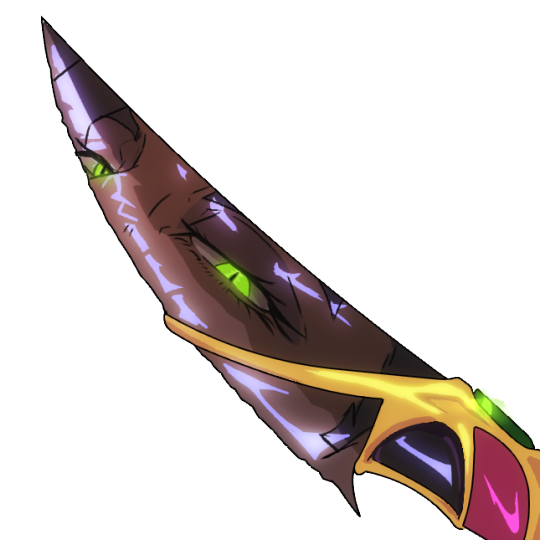
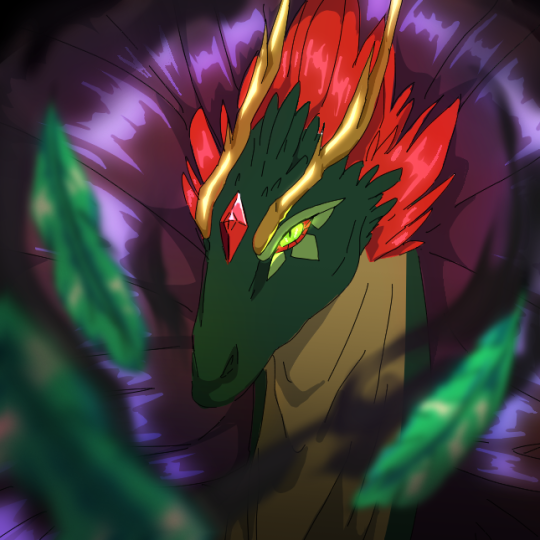
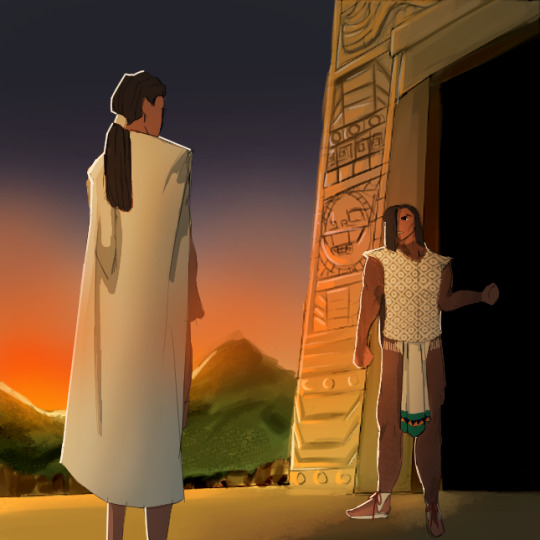
The Punishing Heat spot art for @ifishouldvanish in @castlevaniaszn
Go check out the zine here!
Also here's a tiny peek at my exploration/research stage! I have to give major props to Vanish for giving me a lot of the groundwork to go off. I would've been so lost on where to start without them providing a ton of resources for me!
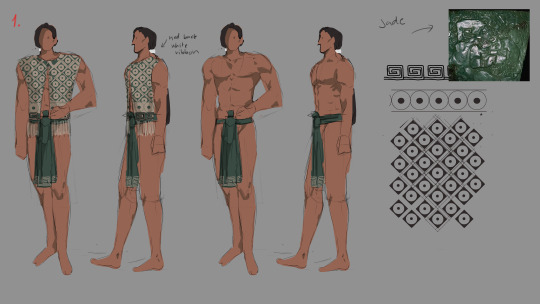
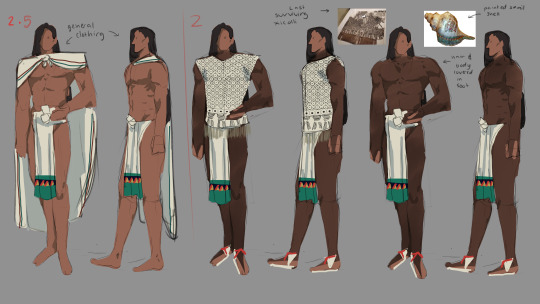
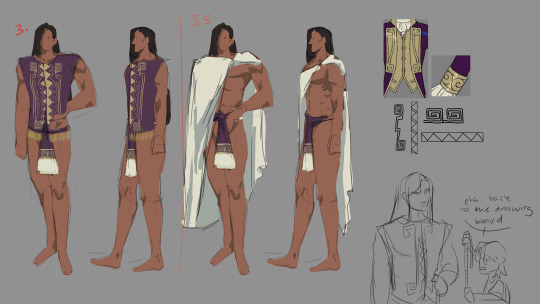
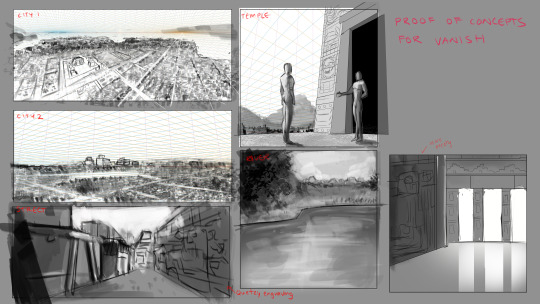
#castlevania nocturne#castlevania#Olrox#castlevania fanart#I was so nervous doing this because i wanted to do Olrox and Cholōllān and Tenōchtitlan justice#rip irl trip for material research you will not be forgotten#thank you vanish for entrusting me with your short story!!
729 notes
·
View notes
Text
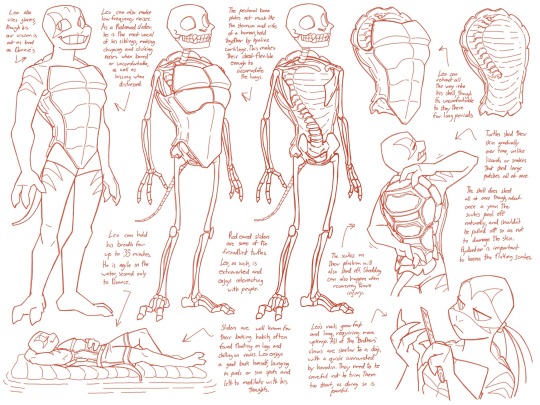
Leo skeletal anatomy! Click for better quality :)
The way most turtles actually fit into their shells is because their arms and legs are shaped to fit into the loose skin around the openings for their limbs, but on account of their human proportions, I just suspend my disbelief as to how mutant turtles could fit in their shells without the odd configuration to their organs that real turtles have. Real turtles have flat lungs that sit widely along their carapace, which is weird but cool. Turtles shed their scutes (the large flat scales on their shells and plastron) about once a year or if the scutes are damaged. The scutes have barely any skin between them and the bone, which is why turtle skeletons usually have the scutes on still, though they can pop off. The rest of the skin sheds regularly though, instead of in large patches.
For the brothers’, their respiration is much more human than turtle. Therefore, their lungs need to expand and contract with their diaphragm rather than just with their movement, so therefore they must have some flexibility to their chest. Some turtles, like box turtles, already have hinged plastrons, and softshell shells are mostly cartilage, so it’s not too far off to assume that there’s a bit of cartilage just to the upper plastral bones of the hard shelled brothers to give their humanoid lungs room to breathe.
Poor Leo. After the movie, one could assume he’s got a couple broken bones. It kind of made me morbidly curious as to how to describe injuries on a character whose skeletal structure is quite different from a human’s for my own writing!
Feel free to use as reference or disregard, these are just my own little speculations :)
[General][Raph][Donnie][Mikey][Splinter]
#rottmnt#rise of the teenage mutant ninja turtles#rise of the tmnt#rise leo#rottmnt leo#speculative biology#skeletons#there’s not a lot of easily digestible material I could find of turtles and how they work#it’s interesting to do research on species that are more obscure than things like cats or horses#my friend: how do you break a charcaters ribs if they don’t have any#me: good question I’m going to draw about it#t*cest dni
2K notes
·
View notes
Text





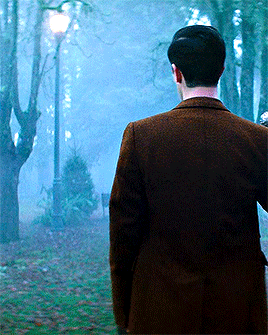



friendly reminder that george took ballet classes!!
#and he apparently made a book of research and materials for each episode??#i’m living off of interviews rn#george rexstrew#edwin payne#jayden revri#charles rowland#kassius nelson#crystal palace#yuyu kitamura#niko sasaki#dead boy detectives#dbd#dbda#the sandman#starlightseraph’s brainrot
1K notes
·
View notes
Note
how do you come up with the ways cultures in your setting stylize people/animals/the world in general in their artwork, i.e. jewlery, rock carvings, statues, etc? Each culture in your world seems to have a very unique "art style" and I love it a lot - makes them seem that much more 'real'. This is something I struggle with a lot in my own worldbuilding and I'd love to pick your brain if possible 😁
I think a starting point is to have a research process based in the material realities of the culture you're designing for. Ask yourself questions like:
Where do they live? What's the climate/ecosystem(s) they are based in? What geographic features are present/absent?
What is their main subsistence method? (hunter gatherer, seasonal pastoralist, nomadic pastoralist, settled agriculturalist, a mix, etc)
What access to broader trade networks do they have and to whom? Are there foreign materials that will be easily accessible in trade and common in use, or valuable trade materials used sparingly in limited capacities?
Etc
And then do some research based on the answers, in order to get a sense of what materials they would have routine access to (ie dyes, metal, textiles, etc) and other possible variables that would shape how the art is made and what it's used for. This is just a foundational step and won't likely play much into designing a Style.
If you narrow these questions down very specifically, (ie in the context of the Korya post- grassland based mounted nomads, pastoralist and hunter-gatherer subsistence, access to wider trade networks and metals), you can direct your research to specific real world instances that fit this general idea. This is not to lift culturally specific concepts from the real world and slap them into your own setting, but to notice commonalities this lifestyle enforces - (ie in the previous example- mounted nomadic peoples are highly mobile and need to easily carry their wealth (often on clothing and tack) therefore small, elaborate decorative artwork that can easily be carried from place to place is a very likely feature)
For the details of the art itself, I come up with loose 'style guides' (usually just in my head) and go from there.
Here's some example questions for forming a style (some are more baseline than others)
Are geometric patterns favored? Organic patterns? Representative patterns (flowers, animals, stars, etc)? Abstract patterns?
Is there favored material(s)? Beads, bone, clay, metals, stones, etc.
When depicting people/animals, is realism favored? Heavy stylization? The emotional impression of an animal? Are key features accentuated?
How perspective typically executed? Does art attempt to capture 3d depth? Does it favor showing the whole body in 2 dimensions (ie much of Ancient Egyptian art, with the body shown in a mix of profile and forward facing perspective so all key attributes are shown)? Will limbs overlap? Are bodies shown static? In motion?
Does artwork of people attempt to beautify them? Does it favor the culture's conception of the ideal body?
Are there common visual motifs? Important symbols? Key subject matters?
What is the art used for? Are its functions aesthetic, tutelary, spiritual, magical? (Will often exist in combination, or have different examples for each purpose)
Who is represented? Is there interest in everyday people? Does art focus on glorifying warriors, heroes, kings?
Are there conventions for representing important figures? (IE gods/kings/etc being depicted larger than culturally lesser subjects)
Is there visual shorthand to depict objects/concepts that are difficult to execute with clarity (the sun, moon, water), or are invisible (wind, the soul), or have no physical component (speech)?
Etc
Deciding on answers to any of these questions will at least give you a unique baseline, and you can fill in the rest of the gaps and specify a style further until it is distinct. Many of these questions are not mutually exclusive, both in the sense of elements being combined (patterns with both geometric and organic elements) or a culture having multiple visual styles (3d art objects having unique features, religious artwork having its own conventions, etc).
Also when you're getting in depth, you should have cultural syncretism in mind. Cultures that routinely interact (whether this interaction is exchange or exploitation) inevitably exchange ideas, which can be especially visible in art. Doing research on how this synthesizing of ideas works in practice is very helpful- what is adopted or left out from an external influence, what is retained from an internal influence, what is unique to this synthesis, AND WHY. (I find Greco-Buddhist art really interesting, that's one of many such examples)
Looking at real world examples that fit your parameters can be helpful (ie if I've decided on geometric patterns in my 'style guide', I'll look at actual geometric patterns). And I strongly encourage trying to actually LEARN about what you're seeing. All art exists in a context, and having an understanding of how the context shapes art, how art does and doesn't relate to broader aspects of a society, etc, can help you when synthesizing your own.
#I have a solid baseline because I like learning about history so don't do this like. Full research process every time. It's just the gist#of what the core process is.#I think I've gotten a similar question about clothing in the past that I never answered (sorry) so yeah this applies to that as well#Though that involves a heavier preliminary research end (given there are substantially more practical concerns that shape the#making of clothing- material sources they have access to (plant textile? wool? hide? etc). The clothing's protective purpose (does#it need to protect from the sun? wind? mild cold? extreme cold?). Etc#Also involves establishing like. Beauty conventions. Gendered norms of dress. Modesty conventions. Etc#I think learning about the real world and different cultures across history is like. The absolute most important thing for good#worldbuilding. And this means LEARNING learning. Having the curiosity to learn the absolute myriad of Things People Do#and Why We Do Them and how we relate to shared aspects of our world. The commonalities and differences. I think this is like...#Foundational to having the ability to synthesize your own rather than just like. copy-pasting concepts at random
373 notes
·
View notes
Text
the ethical or ecological debate about ai isnt even my thing thats not why im not using it:
i
dont
want
to
thats it. i want to have a thought for myself. I want to read and summarize information for myself. I want to look up information without having it reduced to a bite sized paragraph. I want to write a 200 word response or a 20000 word essay by myself. i want to do things by myself, because i am capable of doing it by myself.
if someone else has difficulty writing or drawing or coming up with an idea or what the fuck ever else, this should not mean an entire curriculum is shifted to the point that i cannot be taught to do something without ai being involved, when they were perfectly capable of giving effective feedback not three years prior before this whole thing reached the public. i do not want ai assisted browers, or ai powered this, or ai supported that, for the simple fact that i didnt ask. and now they will not let me turn it off. THAT is my big issue
#the criticism of 'doing x without ai is easy anyone can do it' is ineffectual and subjective#however i simply do not want to. and that choice should be respected. the only note i receive in an english class being 'use ai' is hellis#and indicative of someone who doesnt want to teach#they jsut want to parrot the course material#its why highschoolers struggle with accurately researching information on the computers#theyre told 'look it up and dont use wikipedia'#they are not told WHY or WHERE they should look
94 notes
·
View notes
Text





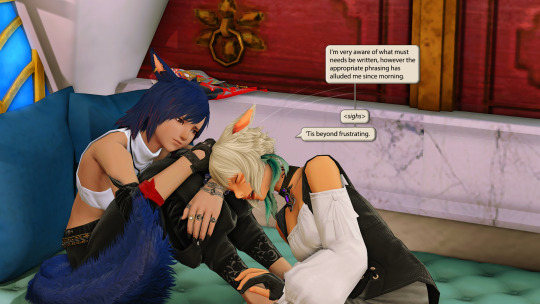



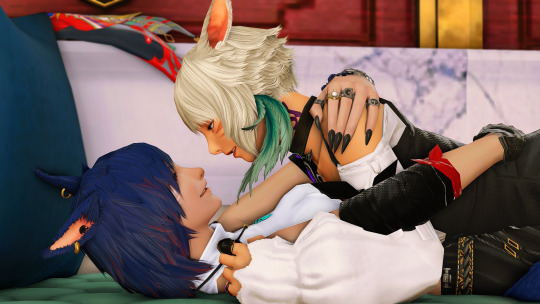







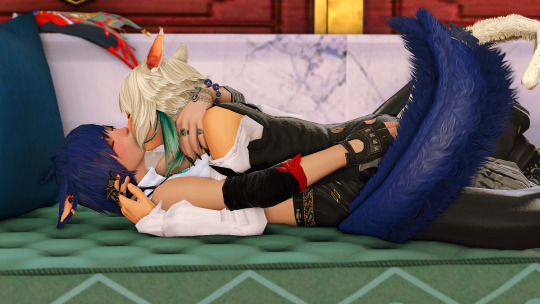

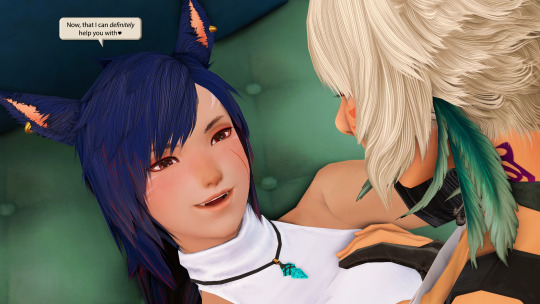
WolShtola Week 2025 - Day Five - Intimacy
Everybody has an off day once and a while, even these two. What's important is that make sure to take care of each other when they do 😌
#ffxiv#ffxiv gpose#wolshtola#wolshtola2025#wolshtolaweek#y'shtola x wol#y'shtola rhul#arsay nun#arshtola#wolnpc#wolship#I know yshtola is slightly more animated in this one but thats the whole point#the intimacy is not just the making out its the fact that neither of them are putting up of a front for each other#Arsay gets to look and feel tired. Y'shtola can be frustrated and emotional. etc.#see you can tell arsay wasnt really planning to go out again cause she took her ribbon off and she only does that when her day is over#and you can tell y'shtola wasn't really focusing on work cause she had sauntered over to their personal bookshelf and not the one in#in her and g'raha's study which would be where all the real research material is#I know in my heart Arsay has used the “papers can wait” type line on G'raha too and it HAS worked#it always works#if you can believe it I had to remodel the graharshtola baldesion annex loft (aka arsays apt) for the 3rd time for this gpose. constant wip
113 notes
·
View notes
Text

Hemp could work as another material to build houses and make them cool in Summer and warm in Winter! Hemp fiber wall, stayed for 4 hours under heat of 360° and barely burned.
Hemp walls are soundproof and act as an insulating layer. Many years ago it was banned for no good reason. 🤔
#pay attention#educate yourselves#educate yourself#knowledge is power#reeducate yourselves#reeducate yourself#think about it#think for yourselves#think for yourself#do your homework#do your own research#do some research#do your research#ask yourself questions#question everything#hemp#good material
215 notes
·
View notes
Text
Me researching genetically engineered fish after spending the last two years obsessing over FFVII and its entire SOLDIER programme subplot:
"I'm going to use this information responsibly" - I lied like the liar I am
Research Variation
Rainbow Trout - To study muscle development
Zebrafish - To study heart tissue repair and failure
Grasscarp - To study lactoferrin
Pet Variation
Zebrafish, Medaka Black tetra, tiger barb - Bred with the green fluorescent protein extract from jellyfish to develop fluorescent lighting when under white and ultraviolet light. Research eventually led to different colourations:
Trademarked names - "Starfire Red", "Moonrise Pink", "Sunburst Orange", "Electric Green", "Cosmic Blue", and "Galactic Purple".
Food Variation
Salmon, trout and tilapia - Injected with growth hormones to increase the rate of development by double or even 100x their regular body weight

#research material#original story: aquarius#a chance to create a genetically engineered monster with mummy issues? don't mind if I do#especially for the shipping potential#an evil love interest who is also big has regenerating powers and...is lactose intolerant?#two out of three ain't bad
3 notes
·
View notes
Text
"Canon Link would never 🙄 He wants to just roam!1!"
Canon Link: I hope my sweet princess graces me with her beautiful voice today. How I wish to see her smile. I need to live up to her feelings
What's that, princess? You need research materials? gives an excess amount of what she asked for
You want my hairtie? Sure! Everything I own is yours
#zelink#totk#botw#legend of zelda#loz#tloz#Link is a simp ok#research materials thing is from age of calamity#he gave her so many frogs that the lab got overrun if I remember correctly#and a very large amount of silent princesses#etc#I think it was something like 3 quests where Zelda asks for something and Link goes overboard lol
687 notes
·
View notes
Text



arcane x cowboy bebop au I
fellas is it gay to give up your career and become wanted criminals to save your lab partner?
#they worked at cherious medical on mars after they graduated SIT#viktor is from venus and suffers from a mutated form of venus sickness which has started to affect his nerves#after it got worse they stole research and materials from the facility to try to cure him#making them wanted criminals#now they search the galaxy (and break into labs) for a cure#making them wanted criminals interplanetary#cait and vi are bounty hunters btw#ANYWAY#arcane#jayvik#viktor arcane#arcane art#jayce talis#arcane au#digital art#my art#artists on tumblr#cowboy bebop#jayce x viktor
86 notes
·
View notes
Text
No I need to make a fucking post about this because I just stumbled on this paper, and this is insane.
Going to be talking about and sharing images of various insects. You have been notified.
So y'all know fleas. The little parasitic insects.

Yeah. Those guys.
Well. This study did genetic analysis on fleas (and several other insects) to find out what these guys derive from. Because up to this point, fleas have been just these weird little things in their own order that are... somewhere??? in the Antliophora clade. Previous scientists have thought maybe they're some weird offshoot of Diptera (true flies), because they do actually have vestigial little wing casings.
But this study, and the genetic analysis they did, revealed that fleas are not especially similar to Diptera. They're actually most similar to Mecoptera. Scorpionflies.

That's right. These guys.
Which is completely and utterly insane to me. You're telling me these big, super unique and specialized, weird-ass bugs, somewhere down the line, created an offshoot of these tiny little insects that lose their wings in favor of hopping around, that parasitize vertebrates and feed on blood? Scorpionflies did that??
Idk this is just. So so interesting to me. The Big wide beautiful world of entomology.
Here's that study. I think you'll have to make an account on the site in order to read it (though I can also just send any interested folks the file I downloaded, since I successfully made an account), but it is SO fascinating.
#i was trying to acces this site for acarology articles for a future paleo class project btw#the prof asked what topic we wanted to do a 15 minute oresentation on and i was like. can i do paleoacarology pleaseeeee#and he was like “if you can find enough material to talk for 15 minutes then sure”#so i was like “yeah bet”#so now i'm looking for fossil mites :]#this was a side-adventure that fascinated me completely#anyway#entomology#bugblr#bugs#fleas#scorpionflies#scientific research#scientific paper
81 notes
·
View notes
Note
You should be a childrens' book illustrator! Your style would be so perfect for that I think! Really unique :D
While I don’t know any children’s literature writers, I *was* commissioned to do illustrations for a medical journal article!
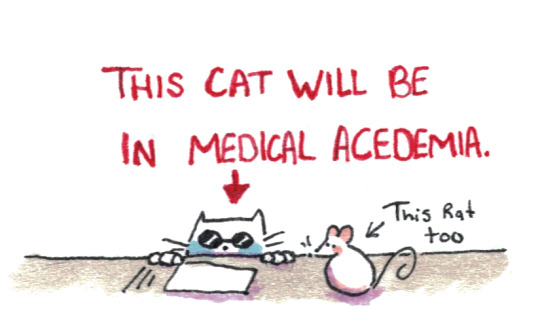
#ask#non-mdzs#This whimsy apparently pairs well with university level reading material.#It is a wild concept to consider! But it *is* reality! I am really doing this! What a twist!#The research is incredible and I'm happy to draw for a beloved friend and good cause B*)#I've definitely got some kidlit illustrators on my inspiration board - I think they do readability and expressiveness well!#Watercolour-like styles also seem rather common so it's probably where the association also comes through#Regardless of my musings! This was a very sweet thing to say; thank you kindly B*)
274 notes
·
View notes
Text
The fun part about biology is explaining to people how field work is done because a lot of it is like as close as we can get to hurting the animals without hurting the animals
like mist netting is a way to catch birds and bats and flying stuff, it's basically very loose, very thin netting that gently catches flying things and tangles them up. Does not hurt them at all but like if you look at a bird in a most net you're gonna really think you're hurting it
there's methods for catching birds of prey that involves basically dragging a live bird on a wire until they swoop in and grab the bird, at which point the biologist trips a net and catches the hawk. Talked to a person who's been doing this for literally 10+ years, and in all of that she's had like 5 birds actually hurt and none lost cause they're wearing these cute little leather vests that protect them from everything. They switch out the birds after each hawk catch too cause the poor guys literally faced death but not actually
And that's not even mentioning the small lizard nooses! Some herpatologists use basically a slipknot (noose) attached to a long stick that they loop around the neck of small lizards. Does not hurt them at all apparently cause they literally don't have enough body mass for the noose to actually constrict much! Controls the head and you can just bend down and grab em
I put mice in plastic bags before (open for air), they try to hide in the corners it's cute
some people put birds upside down in pvc tubes to weigh them
What people need to understand about biology and studying animals is catching them is a difficult and complicated task and we're fucking professionals who know how to do that shit without hurting them, but sometimes the best methods sound horrifying
#not to mention the fact a lot of actual wildlife research is underfunded#a lot of it is ''volunteer'' work and a lot of times materials are paid for out of pocket#like the hawk person I talked to was not paid a cent for her research for years and now is#but only because she worked her way up to hesd researcher#anyway yeah that's the thought process today
102 notes
·
View notes